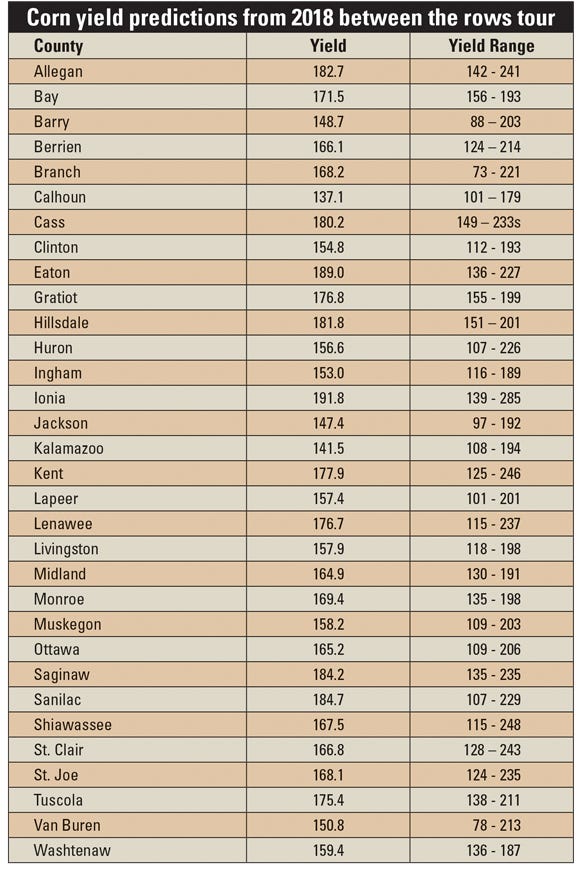
Expect to see huge swings in corn yields this harvest, according to the Michigan Corn Marketing Program of Michigan, which wrapped up its fourth annual Between the Rows Tour the last week of August.
Yield checks were very variable not only throughout the state, but also within each of the 32 Lower Michigan counties sampled.
For instance, Branch County had an average of 168.2 bushels per acre, but yields ranged between 73 and 221 bushels per acre. Van Buren County was similar, with an average of 150.8 bushels per acre, but with a low of 78 and a high of 213 bushels per acre.
Jim Zook, CMPM executive director, says Van Buren County had a lot of rain, and in some of the earlier planted fields, weed control broke down.
CMPM staff checked 10 to 12 cornfields per county for a total of 350 yield samples, and they calculated county-by-county yield averages. The statewide average was weighted based on the percentage of harvested acres from each county, according to Theresa Sisung, CMPM Advocacy and Outreach director.
Statewide, the weighted corn yield was 169.4 bushels per acre.
Both irrigated and nonirrigated cornfields were checked, but Sisung says there were more nonirrigated.
“Variability is the word of the year when we talk about corn yields,” Zook says.

YIELD REPORTS: Theresa Sisung, with the Corn Marketing Program of Michigan, shared yield findings with farmers at a series of meetings around the state. This meeting was at the T Vandenbusche Farms in Jasper.

Weather conditions are at the heart of the issue, he says, as a wet spring in parts of the state delayed planting. However, the later-planted corn, for the most part, was doing better than earlier-planted corn. “Because of timing and a dry and hot July, the earlier-planted corn had more pollination issues,” Zook says. “The later-planted corn had virtually no pollination issues, but there is concern about it getting to maturity. We’ll continue to watch it, because we have seen yields increase later in the season.”
That wasn’t the case last year. The 2017 tour predicted a higher-than-expected 177.5 bushels per acre across 32 counties; USDA had predicted 170 bushels per acre. “Growers were surprised by that figure, but with September getting really hot last year, we lost yield,” Sisung says. “It sort of fell apart at the end of the year, and the final state average yield was 159 bushels per acres.”
Ionia and Eaton counties fared the best during the checks, producing 191.8- and 189-bushel-per-acre averages, respectfully.
Some farmers may be shifting to later-planted corn, Zook says. “It’s not typically what we have been taught in Michigan,” he adds. “But with our changing climate, we’re seeing some of that. Producers need to continue to watch and do what’s comfortable for them on their farm.”
Zook says he’s watching where the rain falls and has noticed a correlation between where the interstate system is located. “Along that strip in Ionia and Eaton counties, where they got rain, that’s where I-69 and I-96 are located,” he says. “Also, along I-80 and I-94, as well as I-69 to Port Huron, there’s been rain. It makes me wonder if wind patterns are being influenced.”
In conjunction with the yield checks, the CMPM staff also hosted eight dinners throughout the state to update local farmers on the yield findings, agronomy challenges, marketing outlook and the work of CMPM.
Staff also conducted a survey of growers where they found 92% of growers said they were somewhat to very concerned with trade issues and NAFTA, 60% were concerned with low commodity prices, and 51% felt the current administration is moving in the right direction.
“Trade policy, the farm bill and ethanol policy were named in order of importance,” Zook says. “We really need a trilevel agreement when it comes to NAFTA.”

USDA issues Sept. 1 crop forecast
August weather was favorable for Michigan corn and soybeans, according to Marlo D. Johnson, director of the USDA National Agricultural Statistics Service’s Great Lakes Regional Office. This report is based on conditions as of Sept. 1. Some highlights of the Crop Production Report follow:
• The average corn yield in Michigan is expected to be 165 bushels per acre, up 6 bushels from 2017, and up 7 bushels from the Aug. 1 forecast. If realized, this will be a record yield.
• For soybeans, a yield of 49 bushels per acre is expected, up 6.5 bushels from last year, and up 3 bushels from the previous month’s estimate.
• Sugarbeet producers expect a yield of 30.4 tons per acre, up 0.4 ton from August, and up 5.2 tons per acre from 2017.
• Nationally, corn production is forecast at 14.8 billion bushels, up 2% from August and up 2% from last year. Based on conditions as of Sept. 1, yields are expected to average 181.3 bushels per acre, up 2.9 bushels from the August forecast and up 4.7 bushels from 2017. If realized, this will be the highest yield on record for the United States. Area harvested for grain is forecast at 81.8 million acres, unchanged from the August forecast, but down 1% from 2017.
• U.S. soybean production is forecast at a record 4.69 billion bushels, up 2% from August and up 7% from last year. Based on Sept.1 conditions, yields are expected to average a record-high 52.8 bushels per acre, up 1.2 bushels from August and up 3.7 bushels from last year. Area for harvest in the United States is forecast at 88.9 million acres, unchanged from August but down 1% from 2017.
• National production of sugarbeets for the 2018 crop year is forecast at 36 million tons, up 2% from last year. Producers expect to harvest 1.10 million acres, down 2% from last year. Expected yield is forecast at 32.8 tons per acre, an increase of 1.1 tons from last year.
Source: NASS
About the Author(s)
You May Also Like






